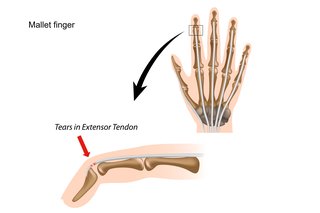Mallet finger is an injury to the end of the finger that causes it to bend inwards towards the palm.
You won't be able to straighten the end of your finger because the tendon connecting the muscle to the finger bone is stretched or torn.

Alila Medical Images / Alamy Stock Photo
Your finger will also be painful and swollen. In some cases, the tendon doesn't tear but a small fragment of bone breaks off the finger where the tendon is attached.
Mallet finger is a common sports injury. It can also happen after catching your finger on something.
When to get medical help
Go to your nearest minor injuries unit as soon as possible if you think you have mallet finger. You'll need to have it splinted.
Try to keep your hand raised until the doctor sees you. This will help reduce any swelling and pain.
If you wear a ring on the affected finger, you should remove it. The swelling may make it difficult to remove the ring later, or it may cut off the blood supply to your finger.
You can take an over-the-counter painkiller, such as paracetamol or ibuprofen, to help relieve the pain.
Once your finger is splinted, applying an ice pack a few times a day for 10 to 20 minutes may also help reduce the pain and swelling.
Treating mallet finger
Your finger will be placed in a plastic splint, which keeps it straight, with the end joint slightly bent backwards. You'll still be able to bend your finger at the middle joint.
The splint is taped on, and must be worn day and night for six to eight weeks to allow the two ends of the torn tendon to stay together and heal. It should only be removed for cleaning.
It's very important that the end of your finger doesn't bend during the time it's splinted because it may slow down healing and reduce the effectiveness of the treatment.
The middle joint of the finger is left free so you can continue to move it to prevent any stiffness developing.
Surgery is only needed if you also have a broken finger, the skin is broken, or in rare cases where mallet finger fails to heal.
How to keep your finger clean
You must keep your splinted finger clean and dry at all times. If the skin inside the splint gets wet it will become very sore.
It's important to wash both your finger and the splint at least once a day, following the instructions below.
- Keep your finger flat on the table, cut the strapping, and slide the splint off your finger.
- Wash and dry your finger and the splint using soap and water. Keep the end joint straight at all times by keeping your finger flat on the table. It may be easier if someone helps you to do this each day, as any movement of the end of your finger will delay the healing of the tendon, and may even cause permanent damage.
- Slide the splint back over the fingertip, still keeping the finger straight.
- Replace the strapping – this should cover the middle of the splint, but shouldn't cover the middle joint of the finger.
Recovery
It should take six to eight weeks for your finger to heal, after which time you'll be able to use it again. You may be advised to continue to only wear the splint at night for up to four more weeks.
In some cases, you may only need to see a specialist once, as a hand physiotherapist may be able to take over your care. They'll give you exercises to do at home to help prevent your finger becoming stiff.
Depending on your job, you may need to take some time off work. You should also avoid sports involving the hands while your injury is healing.
It may take several months for your finger to become fully functional. Redness, swelling and tenderness of the skin around the end of the finger are common for three or four months after injury but usually settle eventually.
You may be left with a small bump on the top of the joint and be unable to fully straighten the joint. Your finger may not be exactly the same as it was before the injury, but overall it should function well.
Page last reviewed: 16 April 2017
Next review due: 16 April 2020
